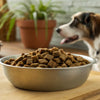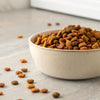How to Wet Dry Dog Food: Elevate Your Dog's Dining Experience
- Houndsy
Table of Contents
- Introduction
- Why Consider Wetting Dry Dog Food?
- How to Wet Dry Dog Food: Different Methods
- Pros and Cons of Wetting Dry Dog Food
- Tips for Successfully Wetting Dry Dog Food
- Conclusion
Introduction
Did you know that nearly 60% of dog owners report their pets being picky eaters at some point? It’s a common concern that can lead to frustration and worry about our furry friends’ nutritional intake. As devoted dog owners, we want nothing but the best for our pets, and ensuring they enjoy their meals is a crucial part of that.
Feeding routines can often become mundane, and some dogs might lose interest in their food, leaving us scratching our heads for solutions. Adding moisture to dry dog food is one effective way to enhance both the taste and texture of their meals, making mealtime a more enjoyable experience. This blog post will explore the benefits of wetting dry dog food, how to do it properly, and the potential impact it can have on your dog's overall health and happiness.
By the end of this article, you will understand not only how to wet dry dog food but also the various methods to do it, the pros and cons of each approach, and tips on how to seamlessly integrate this practice into your daily routine. Let's dive into the world of dog dining and discover how we can elevate our pets' feeding experience!
Why Consider Wetting Dry Dog Food?
Adding water to dry dog food may seem like a simple practice, but it can provide numerous benefits. Here are some key reasons why we might want to consider this technique:
1. Improved Hydration
Dogs, like humans, require adequate hydration to maintain optimal health. While dry kibble is convenient, it often lacks sufficient moisture, which can lead to dehydration, especially in dogs that don't drink enough water. By adding water to their dry food, we can help ensure that our furry friends stay hydrated, particularly in warmer climates or during strenuous activities.
2. Enhanced Palatability
For many dogs, dry kibble can be bland and unappealing. Wetting the food not only makes it softer but also releases the aroma of the kibble, making it more enticing for our pets. This is especially beneficial for picky eaters or dogs recovering from illness, as the added moisture can stimulate their appetite.
3. Easier to Chew and Digest
Older dogs, puppies, or those with dental issues may struggle with hard kibble. Soaking dry food softens it, making it easier for these dogs to chew and digest. This can prevent choking and help ensure that they receive the essential nutrients they need without discomfort.
4. Increased Satiety
Adding water to dry dog food can increase the meal's volume without significantly increasing the calorie count. This can help dogs feel full and satisfied after eating, which is particularly useful for those prone to overeating or weight gain.
5. Prevention of Bloat
Bloat, or gastric dilatation-volvulus (GDV), is a serious condition that can affect deep-chested breeds. While the direct link between wetting food and bloat prevention isn't fully established, some owners believe that soaking kibble may help reduce the risk by allowing for easier digestion.
How to Wet Dry Dog Food: Different Methods
There are several methods to wet dry dog food, each with its own set of advantages. Here’s a closer look at some popular techniques:
1. Adding Water
The simplest way to wet dry dog food is to add water directly to the kibble. Here’s how to do it effectively:
- Measure the Food: Start by measuring the appropriate portion of dry dog food based on your dog's weight and dietary needs.
- Add Water: Pour about ¼ to ½ cup of warm water over the kibble. The exact amount may vary depending on the size of your dog and the kibble's texture.
- Let It Soak: Allow the mixture to sit for about 10-15 minutes, giving the kibble time to absorb the water and soften.
- Serve: Stir the kibble to ensure even moisture distribution, and then serve it to your dog.
2. Using Broth
For an extra flavor boost, consider using low-sodium chicken or beef broth instead of water. This method not only adds moisture but also enhances the taste of the kibble, making it more appealing to your pet. Follow the same steps as above, substituting broth for water.
3. Soaking Overnight
For dogs that require a softer diet, soaking kibble overnight can be beneficial. Here’s how:
- Prep Ahead: Measure the kibble and place it in a bowl.
- Add Water: Cover the kibble with water (make sure it’s submerged).
- Refrigerate: Store the bowl in the refrigerator overnight.
- Serve: In the morning, stir and serve the softened kibble.
4. Warm Water Soak
Using warm water can speed up the soaking process and enhance the aroma of the food:
- Heat Water: Boil water and let it cool slightly (ensure it’s not too hot).
- Mix with Kibble: Pour the warm water over the kibble and let it sit for 5-10 minutes before serving.
5. Mixing in Canned Food
Combining dry kibble with a small amount of canned food can create a delicious and nutritious meal. Simply mix a spoonful of canned dog food with the dry kibble, then add water as needed to moisten the mixture.
Pros and Cons of Wetting Dry Dog Food
While there are many benefits to wetting dry dog food, it’s also essential to consider potential drawbacks. Let’s break down the pros and cons:
Pros
- Increased Hydration: Helps keep dogs hydrated, especially those that don’t drink enough water.
- Better Appetite: Makes meals more appealing to picky eaters.
- Easier to Chew: Beneficial for dogs with dental issues or older dogs.
- Enhanced Satiety: Can help control weight by adding volume without excess calories.
- Potential Bloat Prevention: May help reduce the risk of bloat in susceptible breeds.
Cons
- Spoilage Risk: Wet food can spoil quickly if left out, especially in warm weather. Always serve immediately and discard any leftovers after an hour.
- Less Dental Benefits: Soaked kibble may lose some of its abrasive texture that helps clean teeth.
- Increased Mess: Wet food can be messier to prepare and serve, especially if your dog is prone to making a mess while eating.
- Adjustment Period: Some dogs may need time to adapt to the change in texture and moisture.
Tips for Successfully Wetting Dry Dog Food
To ensure a smooth transition when incorporating wetting into your dog's feeding routine, consider the following tips:
1. Start Slowly
If your dog has never had wet food before, introduce the concept gradually. Begin by adding a small amount of water or broth to see how they react. Observe their response, and adjust the moisture level as needed.
2. Monitor Eating Habits
Keep an eye on your dog's eating habits after introducing wet food. Some dogs may take longer to eat soaked kibble, while others may adapt quickly. Adjust portion sizes or moisture levels accordingly.
3. Maintain Cleanliness
Ensure that you clean your dog's food bowl thoroughly after each meal, especially when using wet food. This helps prevent bacterial growth and keeps your pet healthy.
4. Keep Track of Hydration
If you’re adding water to dry food, be aware of your dog’s overall water intake. Monitor their drinking habits to ensure they are staying hydrated.
5. Consult Your Veterinarian
If you have any concerns about your dog's dietary needs or health conditions, consult your veterinarian before making significant changes to their feeding routine.
Conclusion
Wetting dry dog food can be a game-changer for many pet owners, enhancing palatability, improving hydration, and making meals easier to chew for our furry companions. By exploring various methods of adding moisture to kibble, we can create a delightful dining experience that keeps our dogs happy and healthy.
As we consider making these changes, it’s essential to keep our pets’ individual needs in mind. With thoughtful preparation and observation, we can ensure that this simple practice contributes positively to our dogs’ overall well-being.
Are you ready to elevate your dog's feeding experience? Consider exploring the Houndsy Kibble Dispenser to ensure consistent portion sizes and a stylish addition to your home. Order Now and make mealtime a joyful routine for both you and your beloved pet!
FAQ
1. How much water should I add to dry dog food?
Start with about ¼ to ½ cup of water per meal, adjusting based on your dog's preferences and size.
2. Can I use hot water to soak dry dog food?
Yes, warm water can enhance the aroma and palatability. Just ensure it’s not too hot to avoid burning your dog’s mouth.
3. How long can I leave wet food out?
Wet food should not be left out for more than 60 minutes to prevent spoilage and bacterial growth.
4. Is it okay to mix wet and dry dog food?
Absolutely! Mixing wet and dry food can create a more enticing meal and provide the benefits of both types of food.
5. Should I consult my veterinarian before changing my dog’s diet?
Yes, it’s always best to consult your veterinarian, especially if your dog has specific health concerns or dietary needs.













